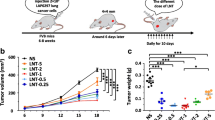Abstract
Background
Interferon γ–inducible protein 10 (IP-10) has antitumor effects in various murine models. The IP-10 receptor has two distinct splice variants, CXCR3A and CXCR3B, that have paradoxical effects after ligand-receptor interaction.
Methods
To characterize the putative antiangiogenic effects of IP-10, we measured proliferation rates and apoptosis in human umbilical vein endothelial cells (HUVECs), fibroblasts, and A375 melanoma or WIDR adenocarcinoma cell lines after exposure to the recombinant protein. CXCR3A (activating) and CXCR3B (inhibitory/proapoptotic) messenger RNA (mRNA) expression levels in fibroblasts, 2 human tumor cell lines, T lymphocytes, and HUVECs of varying cell densities were characterized.
Results
IP-10 resulted in dose-dependent and selective inhibition of proliferation and countered the proliferative effects of vascular endothelial growth factor in HUVECs but did not affect fibroblasts or 2 human tumor cell lines. In addition, IP-10 resulted in potent and selective induction of apoptosis in HUVECS but had no effect on fibroblasts or A375 melanoma. Confluent HUVECs had a predominance of mRNA for the CXCR3B splice variant by reverse transcriptase-polymerase chain reaction, and the ratio of CXCR3B to CXCR3A mRNA was >40 in HUVECs, compared with ≤10 in the other cell types. Moreover, CXCR3B mRNA levels were significantly higher in proliferating compared with confluent HUVECs. In vivo, systemic IP-10 administration resulted in slower A375 xenograft growth rates compared with control-treated animals, and immunohistochemical staining showed decreased microvessel density in xenografts of IP-10–treated mice.
Conclusions
IP-10 has antiangiogenic properties and selective effects on endothelial tissue that may be secondary to higher levels of the CXCR3B inhibitory/proapoptotic receptor in that cell type, particularly in its actively proliferating state.





Similar content being viewed by others
References
Strieter RM, Kunkel SL, Arenberg DA, Burdick MD, Polverini PJ. Interferon gamma-inducible protein 10 (IP-10), a member of the C-X-C chemokine family, is an inhibitor of angiogenesis. Biochem Biophys Res Commun 1995;210:51–7
Folkman J. Angiogenesis in cancer, vascular, rheumatoid and other disease. Nat Med 1995;1:27–31
Cines DB, Pollak ES, Buck CA, et al. Endothelial cells in physiology and in the pathophysiology of vascular disorders. Blood 1998;91:3527–61
Kim KJ, Li B, Winer J, et al. Inhibition of vascular endothelial growth factor-induced angiogenesis suppresses tumour growth in vivo. Nature 1993;362:841–4
Matsuzaki K, Yoshitake Y, Matuo Y, Sasaki H, Nishikawa K. Monoclonal antibodies against heparin-binding growth factor II/basic fibroblast growth factor that block its biological activity: invalidity of the antibodies for tumor angiogenesis. Proc Natl Acad Sci U S A 1989;86:9911–5
Smith DR, Polverini PJ, Kunkel SL, et al. Inhibition of interleukin 8 attenuates angiogenesis in bronchogenic carcinoma. J Exp Med 1994;179:1409–15
Ueki N, Nakazato M, Ohkawa T, et al. Excessive production of transforming growth-factor beta 1 can play an important role in the development of tumorigenesis by its action for angiogenesis: validity of neutralizing antibodies to block tumor growth. Biochim Biophys Acta 1992;1137:189–96
Arenberg DA, White ES, Burdick MD, Strom SR, Strieter RM. Improved survival in tumor-bearing SCID mice treated with interferon-gamma-inducible protein 10 (IP-10/CXCL10). Cancer Immunol Immunother 2001;50:533–8
Luster AD, Greenberg SM, Leder P. The IP-10 chemokine binds to a specific cell surface heparan sulfate site shared with platelet factor 4 and inhibits endothelial cell proliferation. J Exp Med 1995;182:219–31
Luster AD, Cardiff RD, MacLean JA, Crowe K, Granstein RD. Delayed wound healing and disorganized neovascularization in transgenic mice expressing the IP-10 chemokine. Proc Assoc Am Physicians 1998;110:183–96
Cole KE, Strick CA, Paradis TJ, et al. Interferon-inducible T cell alpha chemoattractant (I-TAC): a novel non-ELR CXC chemokine with potent activity on activated T cells through selective high affinity binding to CXCR3. J Exp Med 1998;187:2009–21
Feldman AL, Friedl J, Lans TE, et al. Retroviral gene transfer of interferon-inducible protein 10 inhibits growth of human melanoma xenografts. Int J Cancer 2002;99:149–53
Angiolillo AL, Sgadari C, Taub DD, et al. Human interferon-inducible protein 10 is a potent inhibitor of angiogenesis in vivo. J Exp Med 1995;182:155–62
Luster AD, Leder P. IP-10, a -C-X-C- chemokine, elicits a potent thymus-dependent antitumor response in vivo. J Exp Med 1993;178:1057–65
Taub DD, Lloyd AR, Conlon K, et al. Recombinant human interferon-inducible protein 10 is a chemoattractant for human monocytes and T lymphocytes and promotes T cell adhesion to endothelial cells. J Exp Med 1993;177:1809–14
Lasagni L, Francalanci M, Annunziato F, et al. An alternatively spliced variant of CXCR3 mediates the inhibition of endothelial cell growth induced by IP-10, Mig, and I-TAC, and acts as functional receptor for platelet factor 4. J Exp Med 2003;197:1537–49
Luster AD, Unkeless JC, Ravetch JV. Gamma-interferon transcriptionally regulates an early-response gene containing homology to platelet proteins. Nature 1985;315:672–6
Acknowledgments
The authors thank Romi Sawhney for her assistance with the preparation of this manuscript, Dr. Dominique Lorang for her invaluable assistance with the immunohistochemical staining, and Shawn Farid for his expertise in the use of fluorescence-activated cell-sorting analysis.
Author information
Authors and Affiliations
Corresponding author
Rights and permissions
About this article
Cite this article
Feldman, E.D., Weinreich, D.M., Carroll, N.M. et al. Interferon γ–Inducible Protein 10 Selectively Inhibits Proliferation and Induces Apoptosis in Endothelial Cells. Ann Surg Oncol 13, 125–133 (2006). https://doi.org/10.1245/ASO.2006.03.038
Received:
Accepted:
Published:
Issue Date:
DOI: https://doi.org/10.1245/ASO.2006.03.038




